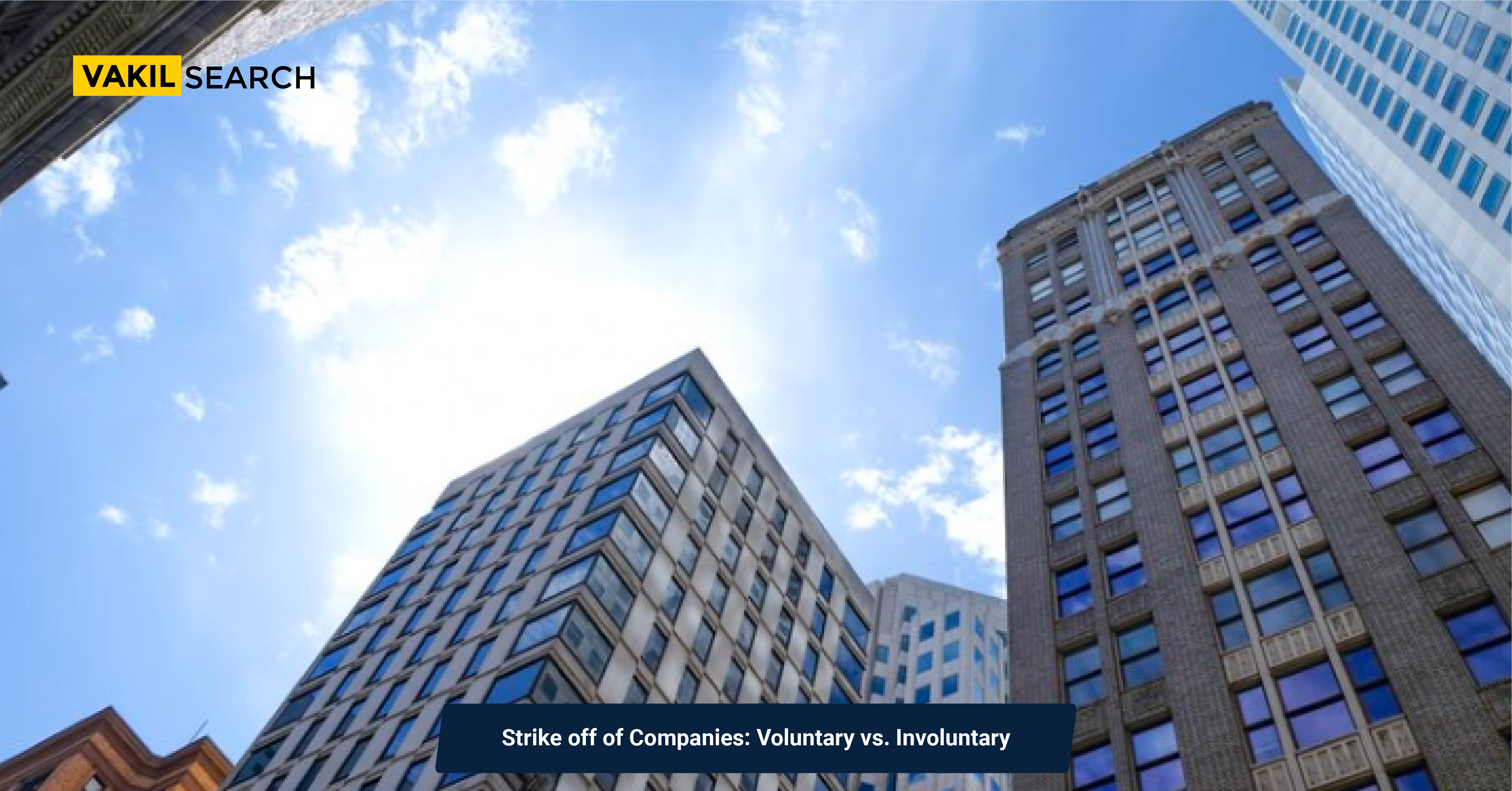Discover the distinctions between voluntary and involuntary company strike-offs in India, including procedures, benefits, and important FAQs.
In the realm of corporate governance, the closure of companies in India can take two distinct paths: voluntary strike-off and involuntary strike-off. Each route has its unique procedures, advantages, and implications.
In this article, we’ll explore the differences between these two approaches, shedding light on the processes and considerations involved.
Voluntary Strike-Off: A Deliberate Choice
Voluntary strike-off, as the name suggests, is a deliberate and proactive decision taken by a company to cease its operations and remove its name from the Register of Companies. This route is chosen when a company wishes to wind up its affairs willingly, typically due to various reasons such as financial insolvency, inactivity, or the fulfilment of its objectives.
Key Steps in Voluntary Strike-Off:
- Resolution: The company’s members pass a resolution in a General Meeting, approving the decision to strike off the company’s name. This resolution also includes finalizing the appointment and remuneration of the liquidator.
- Appointment of Liquidator: The company issues a notice to the Registrar of Companies (RoC) regarding the appointment of a liquidator for the winding-up process. Whether it’s a Member Wind Up or a Creditor Wind Up, must be specified in the declaration.
- Declaration of Solvency: A declaration of financial stability or solvency must be filed, providing details on the company’s financial standing. This declaration is a critical component, as it sets the tone for the voluntary strike-off.
- Liquidator’s Report: The appointed liquidator prepares a report detailing the company’s affairs and presents it at a General Meeting.
- Notice to Registrar: Within a week of the General Meeting, the liquidator sends a report to the Registrar, following the prescribed format.
- Dissolution: If there are no objections or opposition to the strike-off, the company is considered dissolved from the date mentioned in the report.
Benefits of Voluntary Strike-Off:
– Freedom from Debts: After the liquidation process is complete, the company’s directors and administrators are relieved of all financial obligations and debts.
– Legal Protection: Deliberate voluntary strike-off can shield the company from legal actions initiated by courts or tribunals, allowing directors to explore other business opportunities.
– Cost-Effective: Voluntary strike-off typically incurs lower costs compared to other closure methods, making it an economically viable option.
– Contract Termination: Any existing lease agreements or contracts may be terminated during the liquidation process.
– Creditor Security: Creditors benefit from the liquidation process, as they have a chance to recover their dues.
Involuntary Strike-Off: Compelled Closure
In contrast to voluntary strike-off, involuntary strike-off is initiated under specific legal circumstances, often driven by non-compliance or failure to meet statutory requirements. This path is enforced by the authorities when a company fails to fulfil its obligations.
Key Steps in Involuntary Strike-Off:
- Grounds for Winding Up: Various grounds, as specified in Section 433 of the Companies Act, 2013, trigger compulsory winding up, similar to the regulations in new company registration. These grounds include insolvency, inability to pay debts, and court orders.
- Petition to Tribunal: An appropriate person files a winding-up petition before the National Company Law Tribunal (NCLT) based on the existing grounds.
- Tribunal Admission: The NCLT reviews the petition and decides whether to admit it for further proceedings.
- Notice to Registrar: Once the petition is admitted, the Tribunal informs the Official Liquidator, who oversees the winding-up process.
- Statement of Affairs: The company is required to file a statement of its financial affairs with the Official Liquidator.
- Preliminary Report: Within six months, the Official Liquidator submits a preliminary report to the Tribunal.
- Dissolution: After the completion of the liquidation process, the Tribunal initiates the dissolution of the company.
Benefits of Involuntary Strike-Off:
– Creditor Protection: Involuntary strike-off ensures that creditors have a structured process to recover their dues when a company faces financial difficulties.
– Legal Resolution: This method provides a legal framework for addressing non-compliance and financial distress, offering a fair resolution to all stakeholders.
The Bottom Line
In conclusion, the choice between voluntary and involuntary strike-off depends on the circumstances and compliance status of the company.
Voluntary strike-off is a proactive choice, offering advantages such as cost-effectiveness and legal protection. In contrast, involuntary strike-off is enforced by authorities in cases of non-compliance and provides a structured process for addressing financial difficulties and protecting creditors’ interests.
Understanding the differences between these two methods is crucial for companies and directors facing closure decisions. For expert guidance on strike-off procedures and compliance, consider consulting with Vakilsearch, to ensure a smooth completion of your company’s closure process.
FAQs
Can a company choose between voluntary and involuntary strike-offs?
No, the choice between these methods depends on the circumstances and compliance status of the company. Voluntary strike-off is typically chosen when a company wishes to wind up willingly, while involuntary strike-off is enforced by authorities in specific situations.
What happens if a company fails to meet its financial obligations during a voluntary strike-off?
If a company undergoing voluntary strike-off fails to meet its financial obligations, it may face legal actions and complications during the dissolution process.
Is there a timeframe for completing the strike-off process?
The timeframe for completing the strike-off process can vary based on factors such as compliance, objections, and legal proceedings. Generally, voluntary strike-off tends to be quicker compared to involuntary strike-off.

